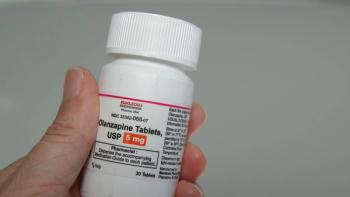
Research is analyzing the effect of imtermittent fasting on quality of life outcomes in patients undergoing radiation therapy.

Research is analyzing the effect of imtermittent fasting on quality of life outcomes in patients undergoing radiation therapy.

Patients with extensive-stage small cell lung cancer tended to have better PFS and OS with complete consolidative radiotherapy compared to incomplete consolidative radiotherapy.

Advanced practice providers discuss the second-line use of elacestrant in patients with co-mutated, ER+, HER2—advanced or metastatic breast cancer

A nurse practitioner discusses ASCO’s recommendations of CDK4/6 inhibitors—namely abemaciclib and ribociclib—in certain high-risk breast cancer settings.

The PDUFA dates have been pushed for sotorasib and obeticholic acid for metastatic colorectal cancer and primary biliary cholangitis, respectively.

Pharmacologic strategies may be able to prevent abnormal uterine bleeding in patients undergoing stem cell transplant.

Nivolumab plus AVD outperformed brentuximab vedotin plus AVD in patients with advanced-stage classical Hodgkin lymphoma.

The FDA accepted a resubmission of a new drug application for frontline rivoceranib plus camrelizumab to treat unresectable, metastatic HCC.

The FDA approved a companion diagnostic for vorasidenib for patients with grade 2 astrocytoma or oligodendroglioma.

An investigational formula of panobinostat called MTX110 may improve outcomes in patients with recurrent glioblastoma.

Pain management specialists were rarely consulted for cancer-related pain, a recent study showed.

Asciminib is a promising agent for frontline chronic myeloid leukemia, Jorge Cortes, MD, explained.

The FDA approved zolbetuximab-clzb plus fluoropyrimidine- and platinum-containing chemotherapy for patients with CLDN18.2-positive locally advanced unresectable or metastatic HER2-negative gastric or gastroesophageal junction (GEJ) adenocarcinoma.

Providers should consider lifestyle preferences and other conditions/comorbidities before deciding between bispecific antibodies or CAR T-cell therapy in myeloma.

“Treatment effectiveness can have different meanings to patients,” a physician assistant said when discussing therapy for high-risk myeloma.

The addition of lurbinectedin to atezolizumab improved OS and PFS in patients with extensive-stage small cell lung cancer.

The addition of T4001, an investigation cancer vaccine, to avelumab did not improve progression-free survival vs avelumab alone in cervical and anogenital tumors.

Oncology nurses play a crucial role in monitoring the severity and frequency of treatment-related symptoms, particularly nausea.

A poll of experts revealed that few are utilizing talquetamab for patients with pretreated relapsed/refractory myeloma.

An analysis of 16 studies showed that CAR T-cell therapy is safe and effective for relapsed/refractory mantle cell lymphoma.

Testing for ESR1 mutations is essential after ER-positive HER2-negative breast cancer progressed.

The DetermalO identified patients with early-stage triple-negative breast cancer who would benefit from presurgical atezolizumab plus carboplatin and nab-paclitaxel.

The FDA granted namodenoson an orphan drug designation for patients who have pancreatic cancer.

Weekly MR-Linac adaptive radiotherapy limited exposure to normal brain tissue in patients with high-grade glioma.

Adding talazoparib to enzalutamide improved survival in patients with metastatic castration-resistant prostate cancer.

NT-17, a long-acting IL-7 agent, enhances CAR T-cell factors associated with efficacy in patients with relapsed/refractory DLBCL when administered 21 days post-CAR T infusion.

Inavolisib plus palbociclib and fulvestrant was approved for the treatment of PIK3CA-mutant, HR-positive, HER2-negative locally advanced or metastatic breast cancer.

The staging of small cell lung cancer significantly impacts treatment plans and potential side effects.

A supplemental biologics license application was submitted for telisotuzumab vedotin for the treatment of metastatic EGFR wild-type nonsquamous non–small cell lung cancer.

Patients with breast cancer who are of childbearing age may face issues that are accentuated by their age, an expert explained.